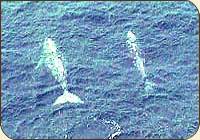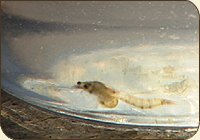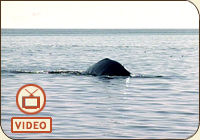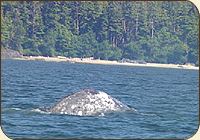|
 |
 |
 |
Vancouver
Aquarium Aquafacts - Gray Whales
Given that the Vancouver Aquarium has no grey whales in its
care, it may be a bit of a mystery why they have an
information page on these large mammals. But these folks are
in the business of informing the general public about what the
natural marine life of the area in which they live is all
about, as much as anything else. So here you'll find a fairly
thorough information page on the grey whale - detailing
everything from what they eat to where they live. There's even
a 'Did You Know' section. No pictures, but nicely presented,
nonetheless.
Visit
this site now
Go to our Links
Section for more online resources
|
 |
 |
ARE THERE TOO MANY GREY WHALES?
 |
| There are now more than
25,000 Pacific grey whales |
By: Steven
Hunt - It's a question that would have been unthinkable
only 60 or 70 years ago. Then again, that was a time when they were at
the brink of extinction. Now at more than 25,000 with an astonishing
annual rate of growth of 3.2 per cent, the question has begun to
surface: are there now too many grey whales? It's not that they're
imposing upon the livelihood of fishers along their migratory path from
Baja, Mexico to Alaska and back again - they only eat crustaceans and
small fish that live near the muddy bottom and they rarely eat at all
while migrating. The question about whether there are too many has
cropped up because an increasing number of carcasses have washed up on
shores along the Pacific coast in the past few years.
 |
| In the past two years, the
number of dead whales washing ashore has risen dramatically. |
Between 1990 and 1997, the number of dead grey
whales along the coast of California ranged from 10 to 16. In 1998, it
increased to 30 and by 1999 it was up to 47. The same thing has also
been seen along the British Columbia coast. Last summer alone, more than
a dozen grey whales were found washed up on the beaches of the lower BC
coast. In fact, two years ago nearly three hundred dead grey whales were
found along their entire migration route.
That number startled some people. Scientists, however, were not so
quick to jump to conclusions. Because these animals feed very little
during migration, it can be difficult interpreting the clues that have
led to these animals' deaths since they have been malnourished and are
more susceptible to disease. But Dr. Dave Duffus of the University of
Victoria does think this is part of the equation. There simply isn't
enough food to go around.
 |
| Mysids and other crustaceans
and small fish make up the majority of the grey whales' diet |
Since the grey whale population is doing so well,
Duffus thinks that the rich waters off Alaska - their normal feeding
grounds in summer - can't accommodate all of the whales. His hunch is
supported by the fact that over 70 grey whales have been documented as
feeding in BC waters for the summer, instead of going further north to
Alaska. The reason? There's food off Vancouver Island that these whales
are taking advantage of, namely crustaceans called mysids. But just
because they're diversifying in the number of locations they feed at
doesn't mean there's necessarily too many of them - even if the numbers
in their deaths are up.
 |
| Click on the image for an @discovery.ca
item on Juanita the grey whale who made Victoria, BC her new
summer home. |
It's all part of the circle of life, as Duffus puts
it. In the years after whaling was banned, grey whales went through a
kind of baby boom, and today, those boomers are 30 and 40 years old.
"The alarm about the dead grey whales is interesting," says
Duffus, "because immediately people are thinking about ecological
circumstances - things like El Nino and ocean change." But as
Duffus points out, it's the baby boom effect at play. "We also have
a lot of animals of a higher age. It's like the baby boomers who are at
retirement age. And of course, they don't go to the retirement villa.
They wash up on the beach."
As Duffus and his fellow researchers have noticed, the documented
dead grey whales did not appear to have been suffering from any
diseases, and besides, most of the animals that are washing ashore are
up around where their life expectancy should be.
 |
So the question about whether there are too many
grey whales may be premature. It does appear some have chosen to not
travel as far to their traditional feeding grounds. Whether that's
because there is a dwindling food supply is not yet clear. As to why so
many whale carcasses have washed ashore recently, for Duffus it appears
to simply be a sign of the times for grey whales - a sign that their
numbers are doing extremely well, and a sign that the first generations
of whales that escaped near extinction over 30 years ago are finally
passing on.

 Grey
Whale Grey
Whale
(Eschrictius robustus)
Habitat: migration patterns allow for two habitats: the
summer feeding grounds from BC, north to the Bering Strait and the
Arctic Ocean; and the breeding grounds off Baja, Mexico in the
winter; they navigate close the shore and follow the contours of the
sea floor.
Length: adults measure roughly 14 metres, on average
Weight: males and females can weigh as much as 30,000
kilograms
Appearance:grey whales have a sharply pointed bowed head, no
dorsal fins and a series of knuckles or bumps along the midline of
their lower back; as their name implies, they are a dark grey to
black colour and have blotches of lighter colours due to barnacles;
their tail flukes are not particularly large, given their size.
Behaviour: grey whales are often seen breaching, leaping into
the air and splashing back into the water; it is thought that
breaching helps them dislodge some of the parasites clinging to
their skin; they are also the only baleen whale species that
regularly feeds on bottom-dwelling animals.
Diet: small, shrimp-like creatures called amphipods are their
mainstay, which live on the muddy ocean floor; they also eat small
fish, herring eggs, tubeworms and mysids; a typical feeding day
consists of 1,200 kilograms of sea food.
Life cycle: grey whales reach sexual maturity anywhere from 5
to 11 years old, or when they reach 11 to 12 metres in length;
gestation lasts from 12 to 14 months.
Life span: a life expectancy of 50 to 60 years is not
uncommon.



 |
The
Sun Bear
|
 |
 |
The
Cheetah
|
 |
 |
The
Grey Whale and Stellar Sea Lions
|
 |
 |
Urban
Australian Animals
|
 |
 |
Grizzly
Bears
|
 |
 |
Deadly
Encounters
|
 |
 |
Rethinking
Zoos
|
 |
 |
Threatened
Birds
|
 |
 |
Reptiles
|
 |
 |
Sonoran
Pronghorns
|
 |
 |
Petrels
and Bobcats
|
 |
 |
African
Penguins
|
 |
 |
Killer
Whales
|
|




